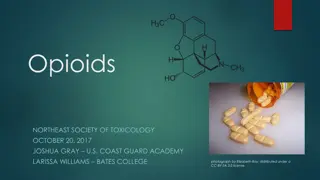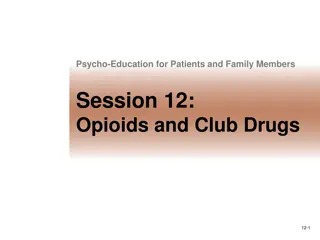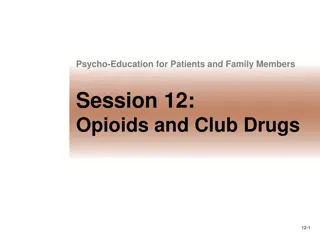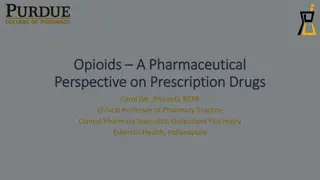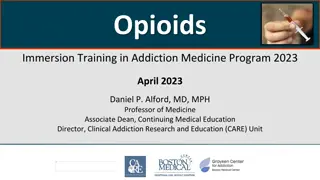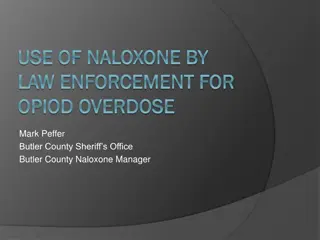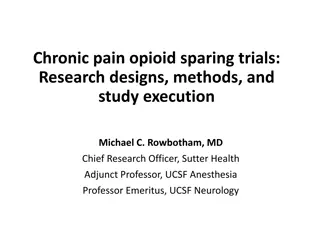Understanding Opioids: Pharmacology and Clinical Applications
Opioids are essential in treating severe and chronic pain, whether malignant or nonmalignant. They are classified based on chemical structure, aiding in identifying potential cross-sensitivity in patients. Opioid agonists interact with specific receptors in the central nervous system and peripheral structures, modulating pain perception and transmission. Morphine, a potent agonist, acts on various receptors to provide analgesia without loss of consciousness. Understanding the mechanisms of action of opioids is crucial for effective pain management.
Download Presentation

Please find below an Image/Link to download the presentation.
The content on the website is provided AS IS for your information and personal use only. It may not be sold, licensed, or shared on other websites without obtaining consent from the author. Download presentation by click this link. If you encounter any issues during the download, it is possible that the publisher has removed the file from their server.
E N D
Presentation Transcript
Opioids 4thStage Dr. Dalia Abd Al- Kader PhD Pharmacology
Opioids considered part of the treatment plan in patients for severe or chronic malignant or nonmalignant pain. Opioids are natural, semisynthetic, or synthetic compounds that produce morphine-like effects
They are divided into chemical classes based on their chemical structure. Clinically this is helpful in identifying opioids that have a greater chance of cross-sensitivity in a patient with an allergy to a particular opioid.
Opioid receptors (mu) analgesic properties mediated by the receptors that modulate responses to thermal, mechanical, and chemical nociception. (kappa) in dorsal horn, contribute to analgesia by modulating response to chemical and thermal nociception. (delta) The enkephalins interact more selectively with receptors in the periphery.
All three opioid receptors are members of the G protein coupled receptor family and inhibit adenylyl cyclase. They are also associated with ion channels, increasing postsynaptic K+ efflux (hyperpolarization) or reducing presynaptic Ca2+ influx, thus impeding neuronal firing and transmitter release
Opioid agonists A.Morphine is the prototype strong receptor agonist. Mechanism of action: -Opioids interact with opioid receptors on the membranes of certain cells in the CNS and other anatomic structures, such as the gastrointestinal (GI) tract and the urinary bladder. -Morphine also acts at receptors in lamina I and II of the dorsal horn of the spinal cord. It decreases the release of substance P, which modulates pain perception in the spinal cord.
-Morphine also appears to inhibit the release of many excitatory transmitters from nerve terminals carrying nociceptive (painful) stimuli. Actions: a. Analgesia: (relief of pain without the loss of consciousness) and relieve pain both by raising the pain threshold at the spinal cord level and, more importantly, by altering the brain s perception of pain.
b. Euphoria: Morphine produces a powerful sense of contentment and well-being caused by disinhibition of the dopamine-containing neurons of the ventral tegmental area. c. Respiration: Morphine causes respiratory depression by reduction of the sensitivity of respiratory center neurons to carbon dioxide. This can occur with ordinary doses of morphine in patients who are opioid-na ve and can be accentuated as the dose is increased until ultimately respiration ceases.
Respiratory depression is the most common cause of death in acute opioid overdoses. Tolerance to this effect does develop quickly with repeated dosing, which allows the safe use of morphine for the treatment of pain when the dose is correctly titrated. d. Depression of cough reflex: Both morphine and codeine have antitussive properties. The receptors involved in the antitussive action appear to be different from those involved in analgesia.
e. Miosis: The pinpoint pupil characteristic of morphine use results from stimulation of and receptors. There is little tolerance to the effect, and all morphine abusers demonstrate pinpoint pupils. [Note: This is important diagnostically, because many other causes of coma and respiratory depression produce dilation of the pupil.] f. Emesis: Morphine directly stimulates the chemoreceptor trigger zone.
g. GI tract: -Morphine relieves diarrhea by decreasing the motility and increasing the tone of the intestinal circular smooth muscle, increases the tone of the anal sphincter. Overall, morphine and other opioids produce constipation, with little tolerance developing. [A nonprescription laxative combination of the stool softener docusate with the stimulant laxative senna is useful to treat opioid-induced constipation.] -Morphine can also increase biliary tract pressure due to contraction of the gallbladder and constriction of the biliary sphincter.
h. Cardiovascular: -at lower doses: no major effects on the blood pressure or heart rate -large doses: hypotension and bradycardia may occur. -Because of respiratory depression and carbon dioxide retention, cerebral vessels dilate and increase cerebrospinal fluid pressure. Therefore, morphine is usually contraindicated in individuals with head trauma or severe brain injury
i. -Morphine releases histamine from mast cells causing urticaria, sweating, and vasodilation. Because it can cause bronchoconstriction, morphine should be used with caution in patients with asthma. j. Hormonal actions: - increases growth hormone release - enhances prolactin secretion - increases antidiuretic hormone and leads to urinary retention. k. Labor: Morphine may prolong the second stage of labor by transiently decreasing the strength, duration, and frequency of uterine contractions. Histamine release
Pharmacokinetics: a. Administration: -Because significant first-pass metabolism of morphine occurs in the liver, intramuscular, subcutaneous, and IV injections produce the most reliable responses. -Absorption of morphine from the GI tract after oral absorption is slow and erratic. -When used orally, morphine is commonly administered in an extended-release form to provide more consistent plasma levels.
b. Distribution: - Rapidly enters all body tissues including the fetuses of pregnant women. - should not be used for analgesia during labor (Infants born to addicted mothers show physical dependence on opioids and undergo withdrawal symptoms if opioids are not administered). -Only a small percentage of morphine crosses the blood brain barrier ( least lipophilic of opioids) . - Fentanyl and methadone (more lipid-soluble opioids) readily penetrate into the CNS.
c. Fate: - Morphine is conjugated with glucuronic acid in the liver to two main metabolites. Morphine-6- glucuronide is a very potent analgesic, whereas morphine-3-glucuronide does not have analgesic activity, but is believed to cause the neuroexcitatory effects seen with high doses of morphine. - The conjugates are excreted primarily in urine, with small quantities appearing in bile. - The duration of action of morphine is 4 to 5 hours when administered systemically to morphine-na ve individuals, but considerably longer when injected epidurally because the low lipophilicity prevents redistribution from the epidural space.
- Age can influence the response to morphine. - Elderly patients are more sensitive to the analgesic effects of the drug, possibly due to decreases in metabolism, lean body mass, or renal function. Lower starting doses should be considered for elderly patients. - Neonates should not receive morphine because of their low conjugating capacity.
Adverse effects: -With most agonists, severe respiratory depression can occur and may result in death from acute opioid overdose. -If opioids are used, respiration must be closely monitored. -Elevation of intracranial pressure, particularly in head injury, can be serious. -Morphine should be used with caution in patients with asthma, liver disease, or renal dysfunction.
Tolerance :Repeated use produces tolerance to the respiratory depressant, analgesic, euphoric, and sedative effects of morphine. However, tolerance usually does not develop to the pupil-constricting and constipating effects of the drug. Physical and psychological dependence Withdrawal produces a series of autonomic, motor, and psychological responses.
Drug interactions: -The depressant actions of morphine are enhanced by phenothiazines, monoamine oxidase inhibitors (MAOIs), and tricyclic antidepressants
Codeine -is a natural opioid -weak analgesic compared to morphine. -used only for mild to moderate pain. -The analgesic actions of codeine are derived from its conversion to morphine by the CYP450 2D6 enzyme system - CYP450 2D6 activity varies in patients, and ultrarapid metabolizers may experience higher levels of morphine, leading to possible overdose. - -Drug interactions associated with the CYP450 2D6 enzyme system may alter the efficacy of codeine or potentially lead to toxicity. - Codeine is commonly used in combination with acetaminophen for management of pain. - Codeine has good antitussive activity at doses that do not cause analgesia. [Note: In most nonprescription cough preparations, codeine has been replaced by drugs such as dextromethorphan, a synthetic cough depressant that has relatively no analgesic action and a relatively low potential for abuse in usual antitussive doses.]
Oxycodone -is a semisynthetic derivative of morphine. -It is orally active and formulated with aspirin or acetaminophen. -Its oral analgesic effect is approximately twice that of morphine. - metabolized via the CYP450 2D6 and 3A4 enzyme systems and excreted via the kidney. - Abuse of the sustained-release preparation (ingestion of crushed tablets) has been implicated in many deaths. Oxymorphone -is a semisynthetic opioid analgesic. -parenterally it is approximately ten times more potent than morphine. -The oral formulation is about three times more potent than oral morphine. - available in both immediate-acting and extended-release oral formulations. - has no clinically drug drug interactions associated with the CYP450 enzyme system.
Hydromorphone - orally active, semisynthetic analogs of morphine -approximately 8 to 10 times more potent than morphine. - preferred over morphine in patients with renal dysfunction due to less accumulation of active metabolites. Hydrocodone - orally active, semisynthetic analogs of codeine -is a weaker analgesic than hydromorphone -oral analgesic efficacy comparable to that of morphine -combined with acetaminophen or ibuprofen to treat moderate to severe pain. -used as an antitussive. -metabolized in the liver to several metabolites, one of which is hydromorphone via the actions of CYP450 2D6.
Fentanyl -a synthetic opioid chemically related to meperidine - has 100-fold the analgesic potency of morphine and is used for anesthesia. -is highly lipophilic and has a rapid onset and short duration of action (15 to 30 minutes). - administered IV, epidurally, or intrathecally. -is combined with local anesthetics to provide epidural analgesia for labor and postoperative pain.
-The oral transmucosal preparation is used in the treatment of cancer patients with breakthrough pain who are tolerant to opioids. -The transdermal patch must be used with caution because death resulting from hypoventilation has been known to occur. - contraindicated in opioid-na ve patients, and patches should not be used in managing acute and postoperative pain -The transdermal patch creates a reservoir of the drug in the skin. Hence, the onset is delayed at least 12 hours, and the offset is prolonged. -metabolized to inactive metabolites by the CYP450 3A4 system, and drugs that inhibit this isoenzyme can potentiate the effect of fentanyl. The drug and inactive metabolites are eliminated through the urine.
Sufentanil, alfentanil, remifentanil -synthetic opioid agonists related to fentanyl. - Sufentanil is more potent than fentanyl, whereas the other two are less potent and shorter acting. - used for their analgesic and sedative properties during surgical procedures requiring anesthesia.
Methadone - is a synthetic, orally effective opioid - induces less euphoria - has a longer duration of action - Its actions are mediated by receptors - is an antagonist of the N-methyl-d- aspartate (NMDA) receptor and a norepinephrine and serotonin reuptake inhibitor. Thus, it has efficacy in the treatment of both nociceptive and neuropathic pain.
-used in the controlled withdrawal of dependent abusers from opioids and heroin. -Oral methadone is administered as a substitute for the opioid of abuse. -The withdrawal syndrome with methadone is milder but more protracted (days to weeks) than that with other opioids. -Unlike morphine, methadone is well absorbed after oral administration. It increases biliary pressure and is also constipating, but less so than morphine. - biotransformed in the liver, and excreted almost exclusively in feces.
- is very lipophilic, leading to accumulation in the fat tissues - half-life of methadone ranges from 12 to 40 hours. It may extend up to 150 hours, although the actual duration of analgesia ranges from 4 to 8 hours. - Upon repeated dosing, methadone can accumulate due to the long terminal half-life, thereby leading to toxicity.
-Can produce physical dependence like that of morphine, but has less neurotoxicity than morphine due to the lack of active metabolites. - Can prolong the QT interval and cause torsades de pointes, possibly by interacting with cardiac potassium channels. It should be used with caution in patients with a family or personal history of QT prolongation or those taking other medications that can prolong the QT interval.
Meperidine - is a lower-potency synthetic opioid - structurally unrelated to morphine. - used for acute pain and acts primarily as a agonist, with some agonist activity also. - is very lipophilic and has anticholinergic effects, resulting in an increased incidence of delirium - The duration of action is slightly shorter than that of morphine and other opioids.
- has an active metabolite (normeperidine) that is renally excreted. Normeperidine has significant neurotoxic actions that can lead to delirium, hyperreflexia, myoclonus, and possibly seizures. - Due to the short duration of action and the potential for toxicity, meperidine should only be used for short-term ( 48 hours) management of pain. - should not be used in elderly patients or those with renal insufficiency, hepatic insufficiency, preexisting respiratory compromise, or concomitant or recent administration of MAOIs. Serotonin syndrome has also been reported in patients receiving both meperidine and SSRIs.
Partial agonists and mixed agonistantagonists Partial agonists bind to the opioid receptor, but have less intrinsic activity than full agonists. Mixed agonist antagonists - drugs that stimulate one receptor but block another. The effects of these drugs depend on previous exposure to opioids. - In individuals who have not received opioids (na ve patients), show agonist activity and are used to relieve pain. - In the patient with opioid dependence, the agonist antagonist drugs may show primarily blocking effects (that is, produce withdrawal symptoms).
Buprenorphine - a partial agonist, acting at the receptor. - acts like morphine in na ve patients, but it can also precipitate withdrawal in users of morphine or other full opioid agonists. - A major use is in opioid detoxification, because it has shorter and less severe withdrawal symptoms compared to methadone
-It causes little sedation, respiratory depression, or hypotension, even at high doses. - administered sublingually, parenterally, or transdermally and has a long duration of action because of its tight binding to the receptor. -Buprenorphine tablets are indicated for the treatment of opioid dependence and are also available in a combination with naloxone. -Naloxone was added to prevent the abuse of buprenorphine via IV administration.
-The injectable form and the once-weekly transdermal patch are indicated for the relief of moderate to severe pain. - metabolized by the liver and excreted in bile and urine. - Adverse effects include respiratory depression that cannot easily be reversed by naloxone and decreased (or, rarely, increased) blood pressure, nausea, and dizziness.
Pentazocine - agonist on receptors - a weak antagonist at and receptors. - promotes analgesia by activating receptors in the spinal cord, and it is used to relieve moderate pain. - administered either orally or parenterally. - produces less euphoria compared to morphine. - In higher doses causes: respiratory depression decreases the activity of the GI tract increase blood pressure hallucinations, nightmares, dysphoria, tachycardia, and dizziness. -Despite its antagonist action, pentazocine does not antagonize the respiratory depression of morphine, but it can precipitate a withdrawal syndrome in a morphine abuser. -Tolerance and dependence develop with repeated use. -should be used with caution in patients with angina or coronary artery disease, since it can increase systemic and pulmonary arterial pressure and, thus, increase the work of the heart.
Nalbuphine and butorphanol - mixed opioid agonist antagonists. - Butorphanol is available in a nasal formulation that has been used for severe headaches, but has also been associated with abuse. - not available for oral use. - Psychotomimetic effects is less than that of pentazocine. - Nalbuphine does not affect the heart or increase blood pressure, in contrast to pentazocine and butorphanol.
OTHER ANALGESICS Tapentadol -a centrally acting analgesic, is an agonist at the opioid receptor and an inhibitor of norepinephrine reuptake. - Used to manage moderate to severe pain, both chronic and acute. - Metabolized to inactive metabolites via glucuronidation, and it does not inhibit or induce the CYP450 enzyme system. Because tapentadol does not produce active metabolites, dosing adjustment is not necessary in mild to moderate renal impairment. - should be avoided in patients who have received MAOIs within the last 14 days. - available in an immediate-release and extended- release formulation.
Tramadol -a centrally acting analgesic that binds to the opioid receptor. -undergoes extensive metabolism via CYP450 2D6, leading to an active metabolite with a much higher affinity for the receptor than the parent compound. - Weakly inhibits reuptake of norepinephrine and serotonin. -It is used to manage moderate to moderately severe pain. -Its respiratory depressant activity is less than that of morphine. -Naloxone can only partially reverse the analgesia produced by tramadol or its active metabolite. -Anaphylactoid reactions have been reported. -Overdose or drug drug interactions with medications, such as SSRIs, MAOIs, and tricyclic antidepressants, can lead to toxicity manifested by CNS excitation and seizures. - has been associated with misuse and abuse.
ANTAGONISTS The opioid antagonists bind with high affinity to opioid receptors, but fail to activate the receptor-mediated response. Administration of opioid antagonists produces no profound effects in normal individuals. However, in patients dependent on opioids, antagonists rapidly reverse the effect of agonists, such as morphine or any full agonist, and precipitate the symptoms of opioid withdrawal.
Naloxone - Within 30 seconds of IV injection of naloxone, the respiratory depression and coma characteristic of high doses of morphine are reversed, causing the patient to be alert. - has a half-life of 30 to 81 minutes; therefore, a patient who has been treated and recovered may lapse back into respiratory depression. -is a competitive antagonist at , , and receptors, with a 10-fold higher affinity for than for receptors. This may explain why naloxone readily reverses respiratory depression with only minimal reversal of the analgesia that results from agonist stimulation of receptors in the spinal cord. - There is little to no clinical effect seen with oral naloxone, but, upon IV administration, opioid antagonism occurs, and the patient experiences withdrawal.
Naltrexone -has actions similar to those of naloxone. - has a longer duration of action than naloxone, and a single oral dose of naltrexone blocks the effect of injected heroin for up to 24 hours. - in combination with clonidine (and, sometimes, with buprenorphine) is used for rapid opioid detoxification. - Although it may also be beneficial in treating chronic alcoholism, benzodiazepines and clonidine are preferred. - Naltrexone can lead to hepatotoxicity.




